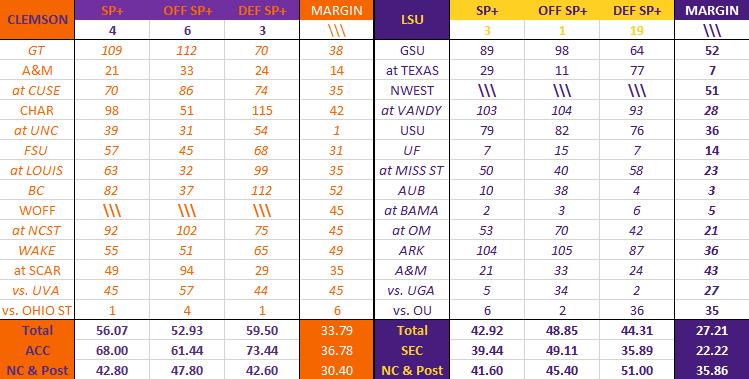
Dialogue surrounding the College Football Playoff National Championship has focused on the perceived lack of depth in Clemson’s schedule compared to LSU’s.
The narrative essentially boils down to this: No. 3 and defending national champion Clemson (14-0) of the less-challenging Atlantic Coast Conference skated through its regular season while No. 1 LSU (14-0) was pressed harder in the battle-tested SEC. Therefore, the Bayou Bengals will have the upper hand in the College Football Playoff national championship game in their own backyard when the teams meet Jan. 13 in New Orleans in the Mercedes Benz Superdome where LSU won national titles in 2003 and 2007.
Case closed, end of story.
Well, not exactly. According to ESPN’s Bill Connelly’s SP+ metric, which models a team’s efficiency while adjusting for opponents as necessary, both teams are squarely matched.
After the conference championship games, LSU ranked third in the rankings with Clemson right behind them. LSU is ranked first in the nation in the offense-only portion of the metric while Clemson is sixth. In defensive SP+, LSU is 19th while Clemson is third.
In other words, it’s bound to be a great national championship game between two equal teams.
But how much weight is there to the strength of schedule debate? Does LSU have a bigger advantage due to being “tested” more often? Let’s find out by expanding these comparative numbers to each opponent LSU and Clemson played over the course of the season:

Just to quickly explain the graphic: the overall, offensive, and defensive SP+ rankings for each team on the schedule are displayed along with the margin of victory. At the bottom the numbers are averaged out on the overall, conference, and non conference/postseason basis. LSU’s and Clemson’s FCS opponent (Northwestern State and Wofford respectively) is omitted from the SP+ averages, but not the margin of victory average.
So what did we learn?
LSU did have a harder schedule than Clemson did, especially in conference play. LSU’s opponents averaged an SP+ ranking of 43 while Clemson’s averaged 56. The SEC slate LSU played had an average ranking of 39 compared to the Clemson’s ACC average of 68.
The non-conference schedules are pretty comparable, though.
LSU faced a decidedly better team (Georgia) in its conference championship game than Clemson (Virginia), but Clemson played two SEC teams in its regular season to balance things. Both teams played and defeated top five ranked teams — LSU over No. 4 Oklahoma and Clemson over No. 2 Ohio State — in the CFP semifinals.
But while Clemson had a more manageable schedule, it also handled its opponents better than LSU did. While LSU’s average margin of victory is 27 points, Clemson’s average victory margin is 34. In conference play, that gap separates even farther to 37 points for Clemson and 22 for LSU.
Thanks to LSU’s back-to-back blowouts over Georgia in the SEC championship game and Oklahoma in the CFP semi in Atlanta’s Mercedes Benz Stadium, LSU has a larger margin of victory against non-conference and postseason opponents.
Before the Fiesta Bowl CFP semi against Ohio State, the only time Clemson had a game decided by less than two touchdowns was the one-point victory over North Carolina in Chapel Hill on Sept. 28 in the fifth game of the season. The Tar Heels elected to go for a two-point conversion and the win rather than kicking a game-tying extra point to send the game to overtime.
Clemson wouldn’t play a team better than the Tar Heels until they met the Buckeyes but regardless they shifted into another level of play after the close call. The ACC Tigers have won their nine games since the escape at UNC by an average of 42 points.
The Fiesta Bowl was the first time Clemson was seriously challenged since UNC, and it was pushed hard. The Tigers of the orange and purple variety trailed 16-0 with 7:20 left in the second quarter, the first time they faced a deficit in the last 15 months.
But Clemson scored 14 points in the final 2:45 of the first half and scored the game-winning TD on a 94-yard drive for the 29-23 victory, the Tigers’ 29th consecutive win.
So yes, Clemson did play worse teams than LSU did across the stretch of the season, but it beat its opponents by a wider margin to compensate outside of the close call against North Carolina. When Clemson did have to play a team its equal in Ohio State, the Tigers rebounded after getting pushed around early to win and earned their trip to New Orleans to play for the national title for the fourth time in the last five years.


There is one glaring problem with this ranking and article.
That is the ranking for the Defenses. To ignore how the LSU Defense has been playing in the last few games, compared to how they played earlier in the season ignores that drastic improvement completely
It is true that LSU’s defense has vastly improved, but that’s not exactly the point. We’re simple comparing the two team’s schedule and the teams they have played. No point in cherry picking LSU’s defensive rankings to improve their numbers when that’s not exactly what we’re looking at.
Thanks!!! You are funny! You are deleting my comments that are relevant to the issue. Good journalism! Keep it up!
So, do you think that Vegas takes into account the drastic improvement in the LSU Defense when trying to figure out who will win this game?
I promise you that they are.
The problem here is: Clemson’s numbers against inferior opponents is supposed to give them bigger margins of victory! Using that as a matrix to show they are equal is totally flawed science! But we know numbers are there to be tweaked and say what we want them to say. One common opponent here A&M. Clemson +14 at home, LSU +43 at home. At the end of the day none of this matters. Tune in on Jan. 13th and see what we get.
Blowout games mean little. We called off the dogs in many games . I don’t know if Clemson did the same. That could account for margin of victory. LSU did not keep starters in for much of fourth qtr in many games including CFP. Could have scored at will on those guys. Just sayin..data is flawed.
I dont care about the improvement of the defense. Flip-flop the schedules and the margin of victory goes out of the window. Clemson struggling early on would’ve ended its march into the playoffs. As soon as it hit the SEC schedule, the rubber would’ve met the road. Credit for playing two SEC teams. They always play South Carolina. Texas A&M is a worthy opponent but running the gauntlet of Florida, Auburn, Alabama and Georgia would’ve made for an A&M type finish for Clemson, hence the tough schedule argument. The ACC is weak and you can’t change that but you must understand the argument. LSU gets blasted when it loses to Alabama and Florida. Clemson gets blasted for UNC taking it to the limit.